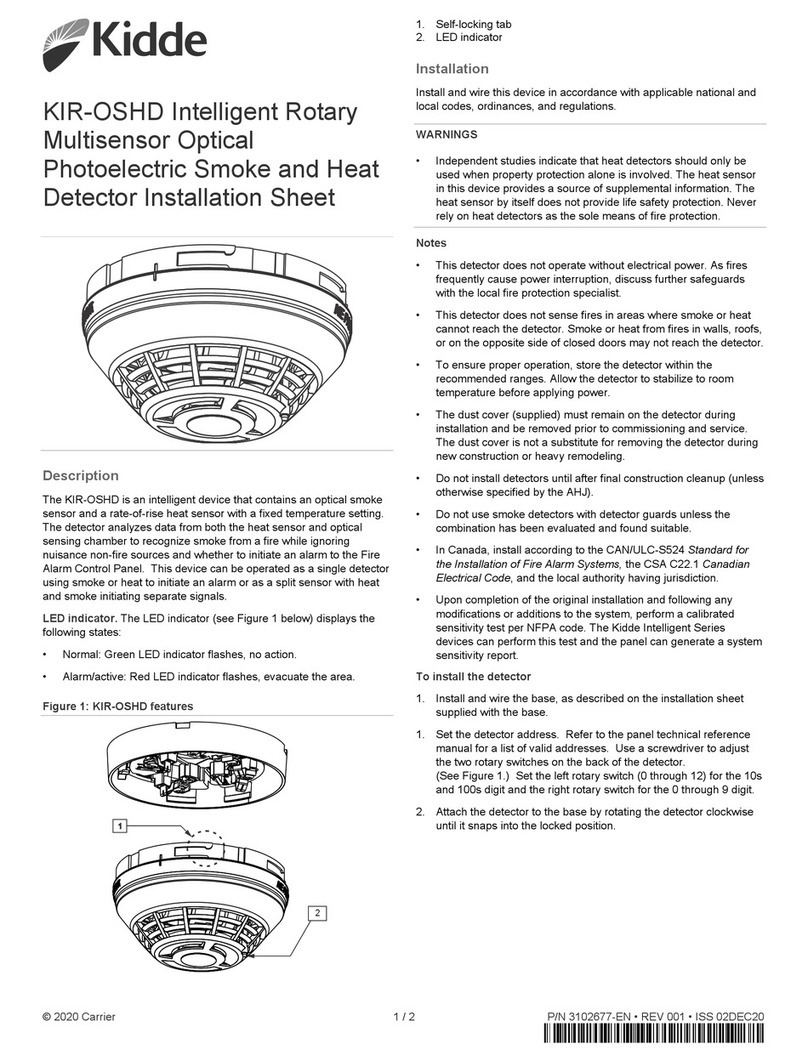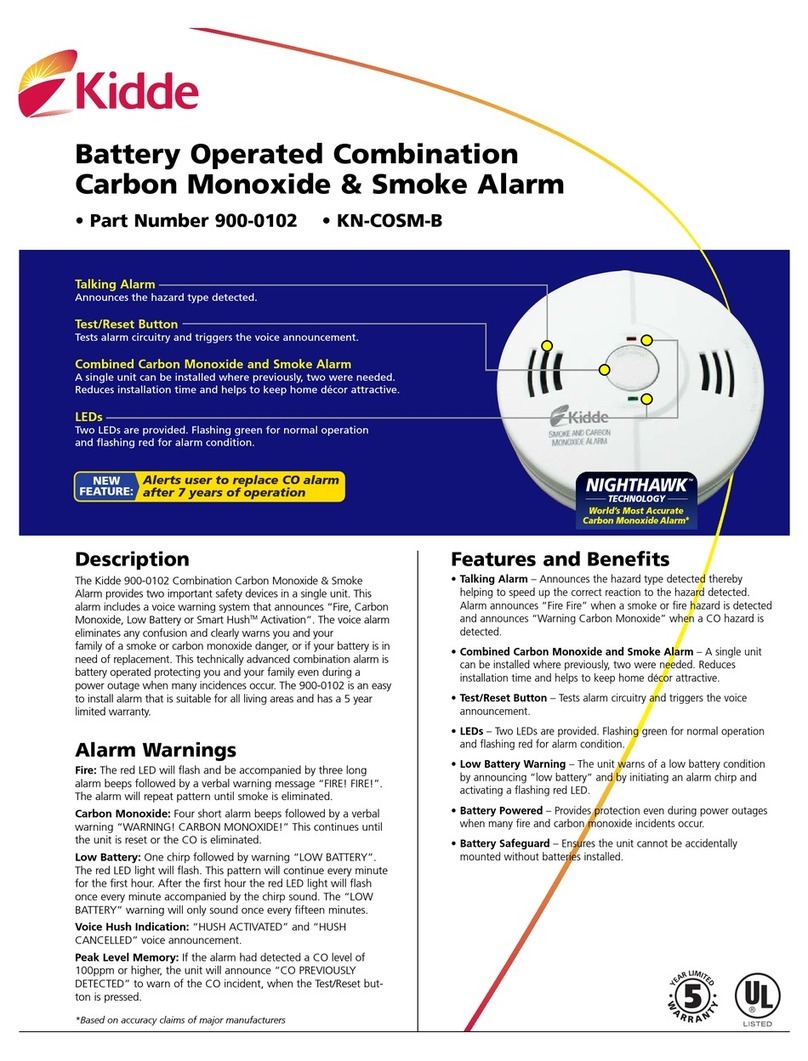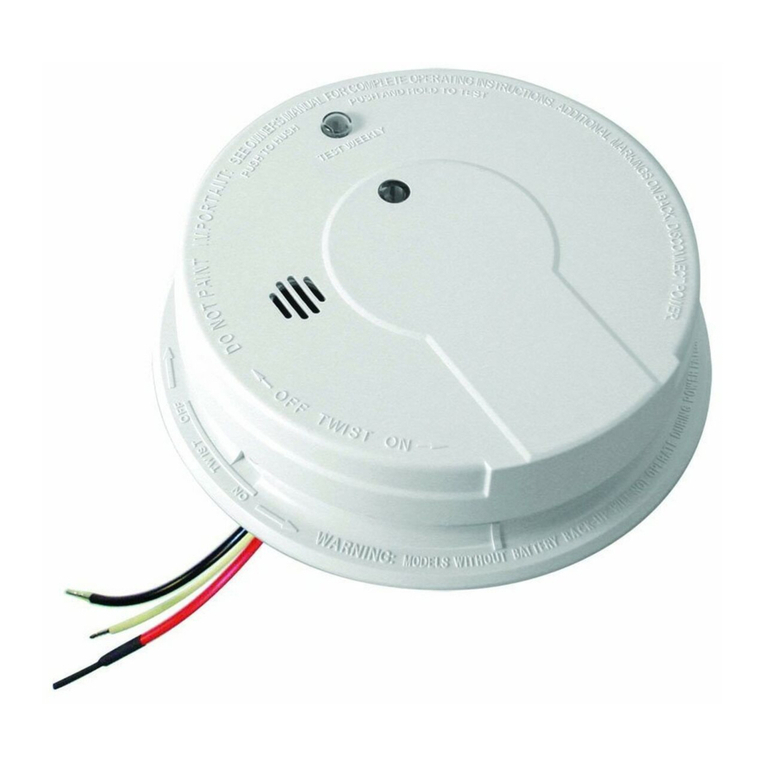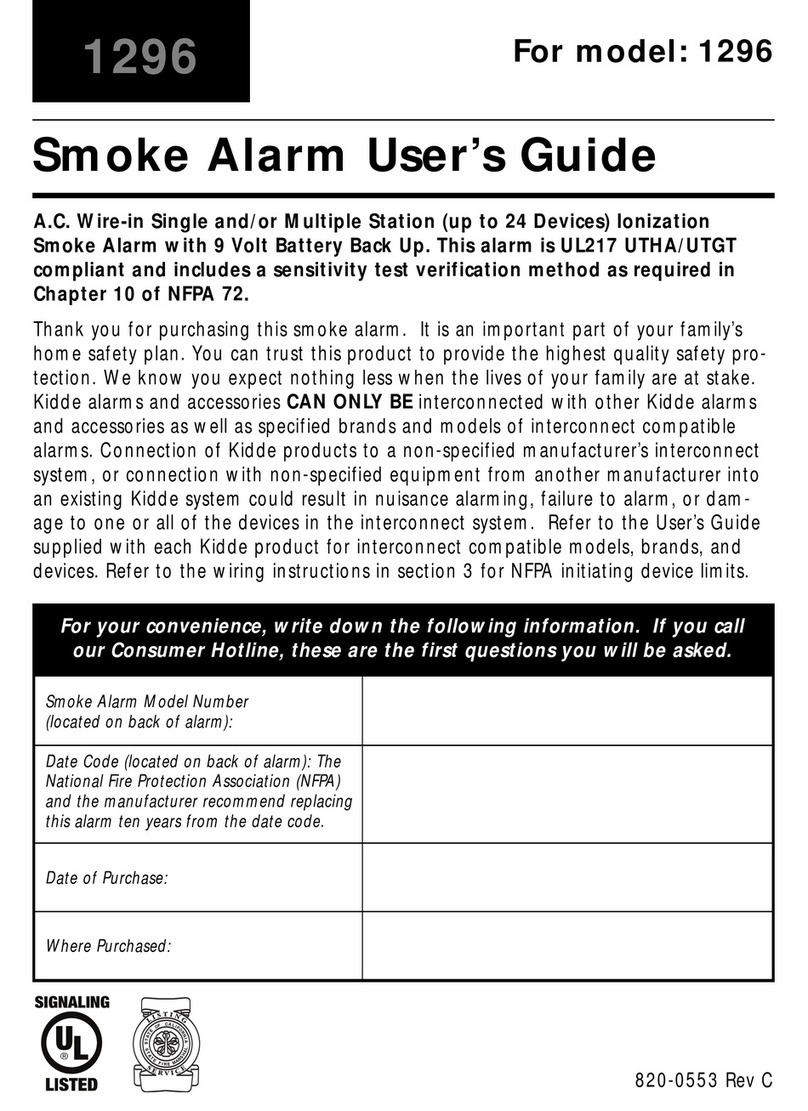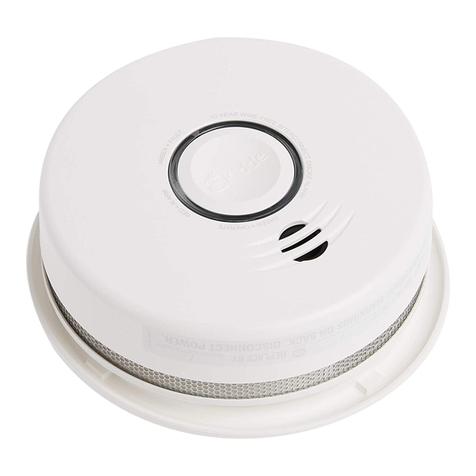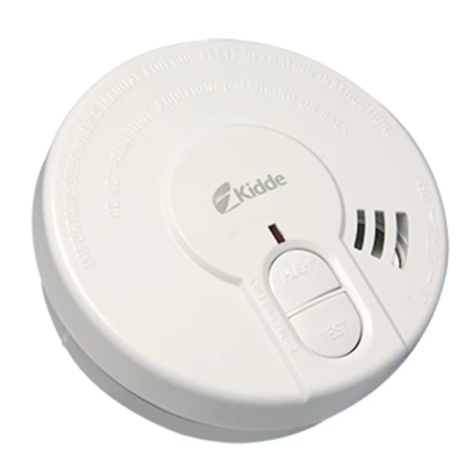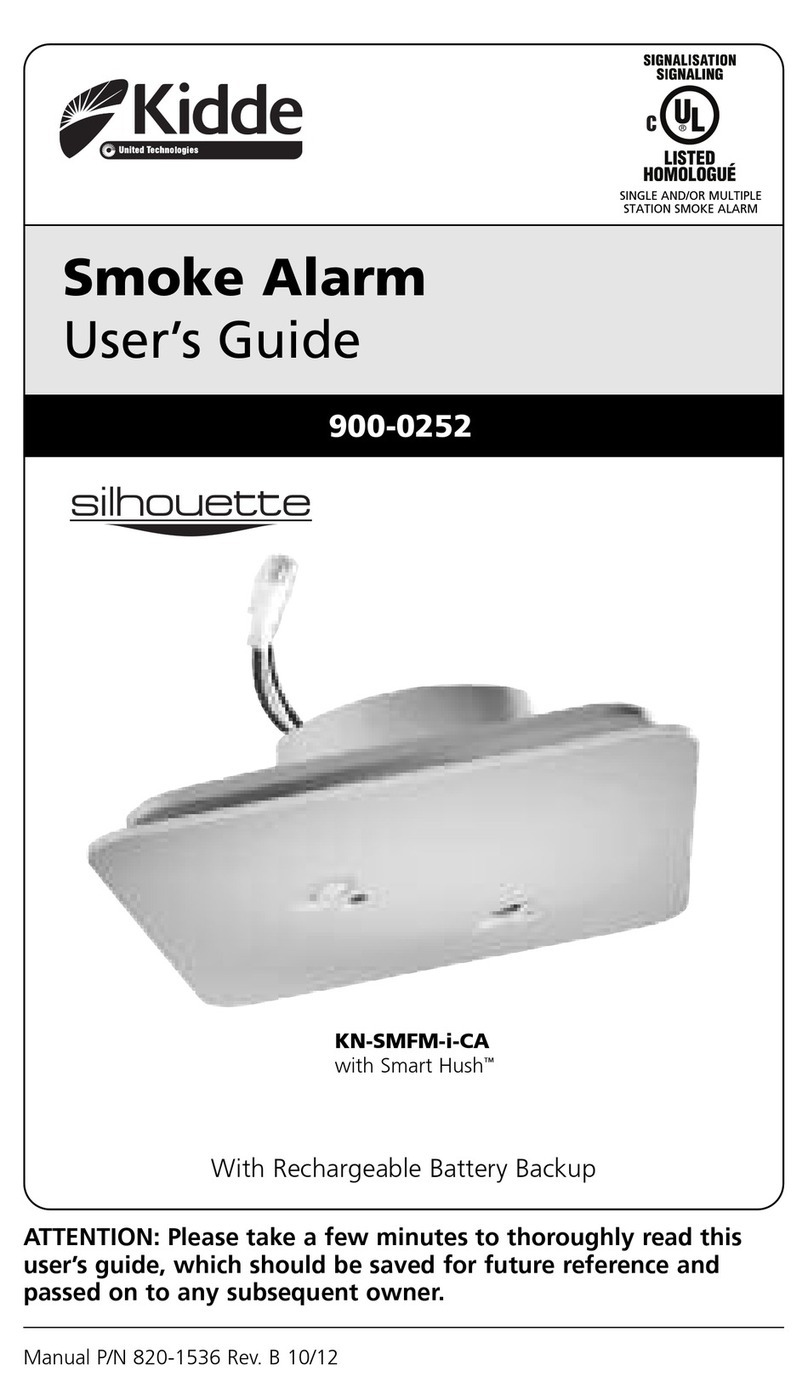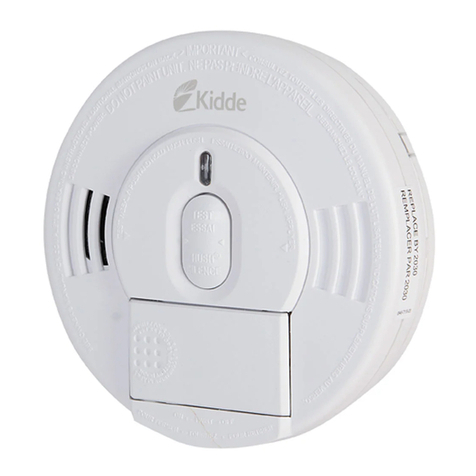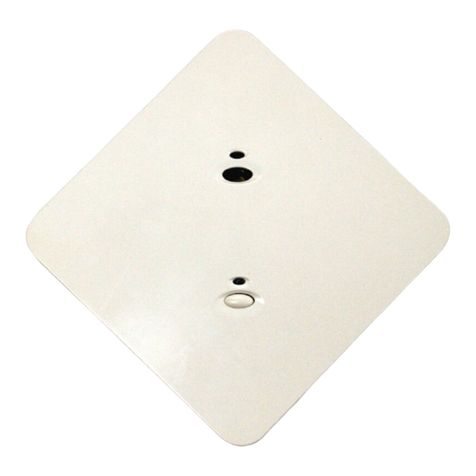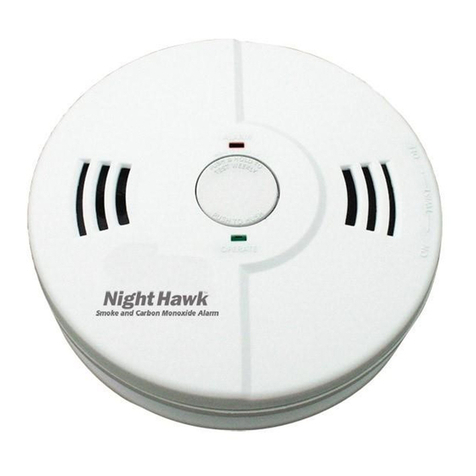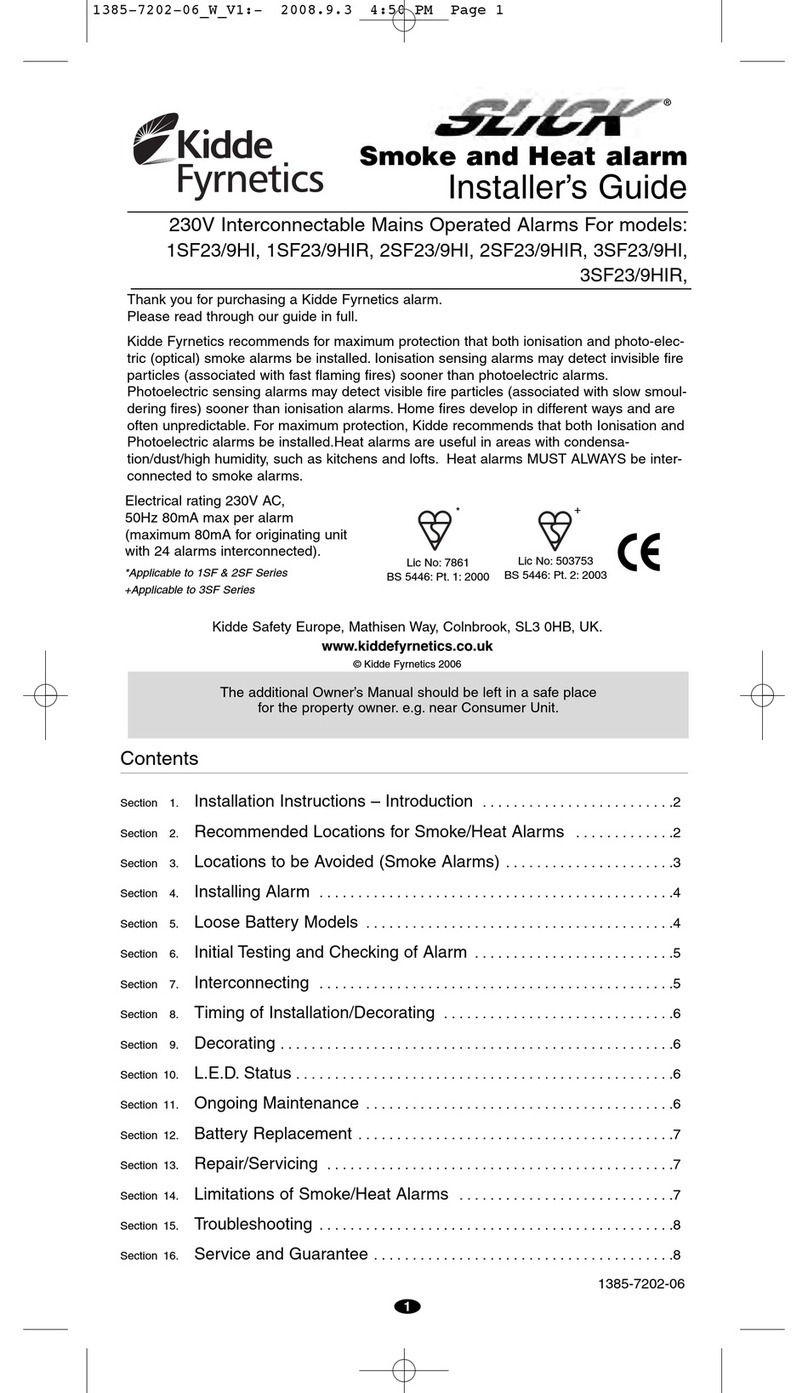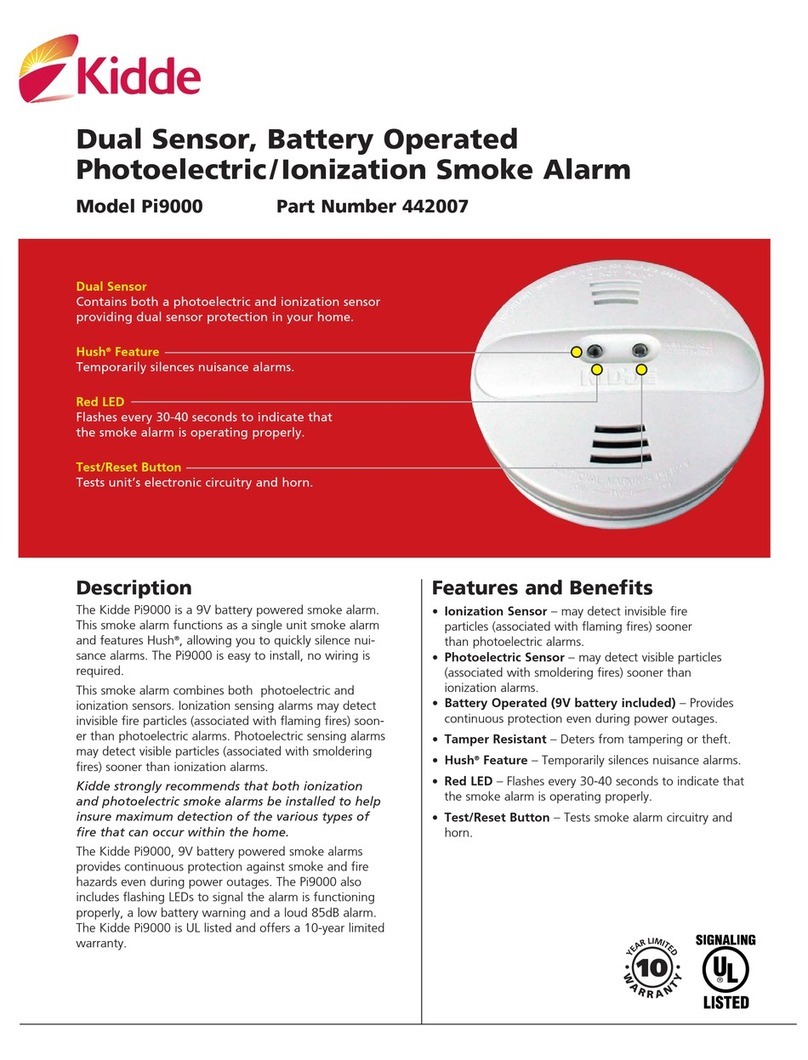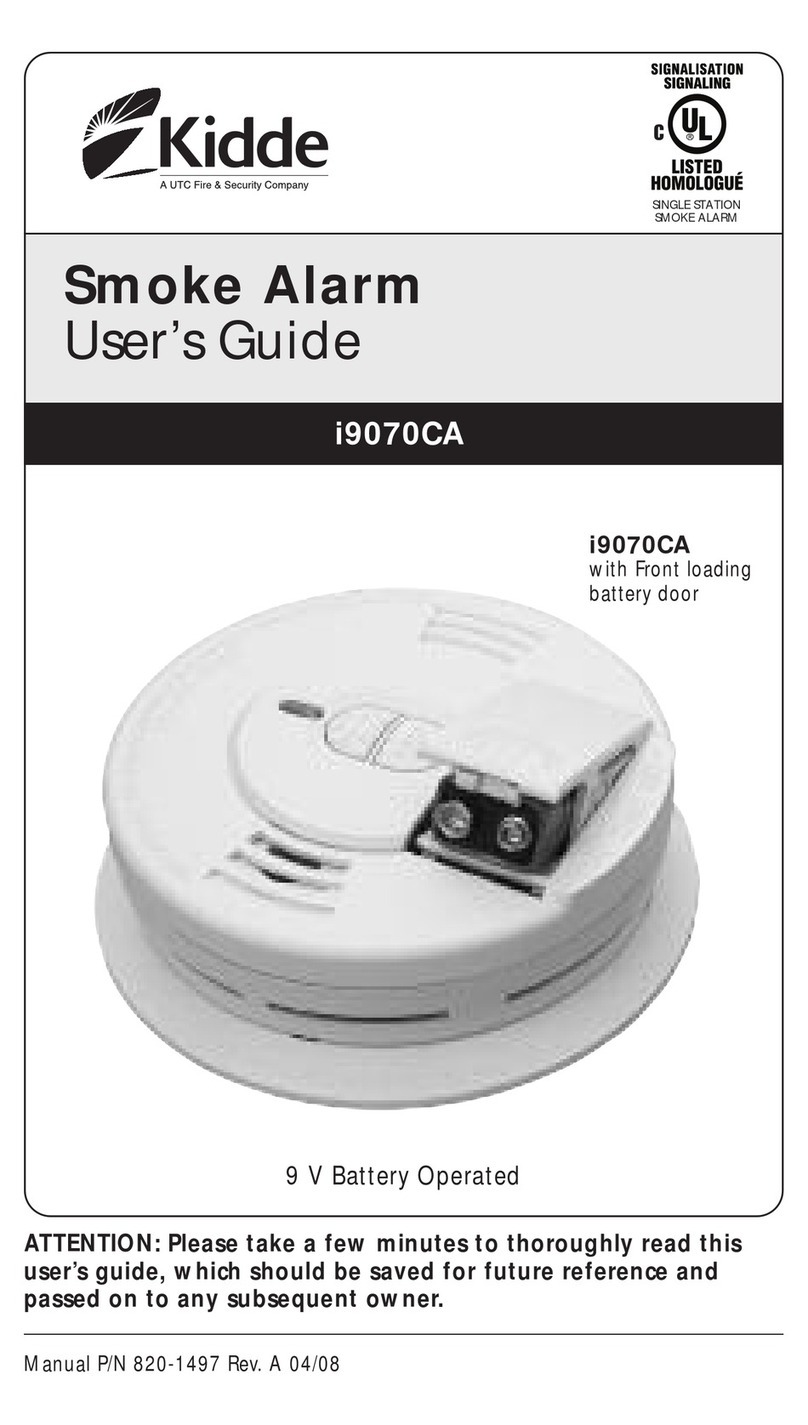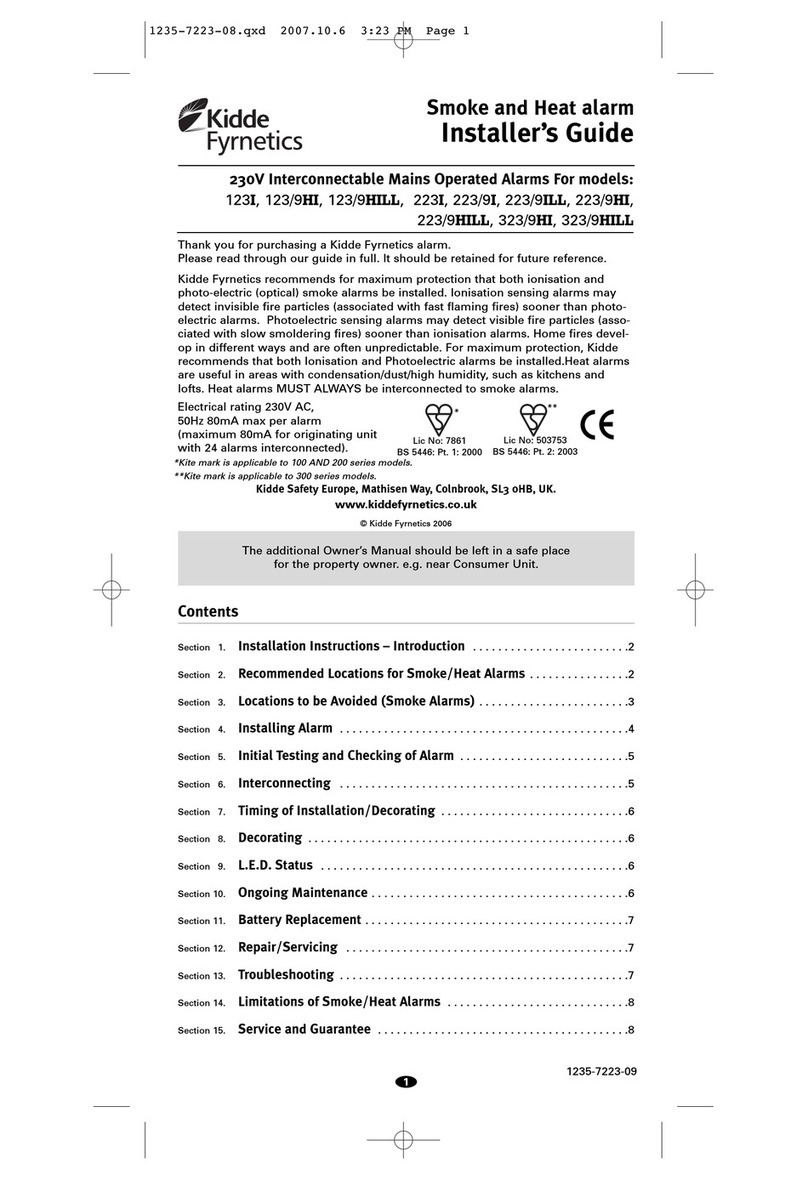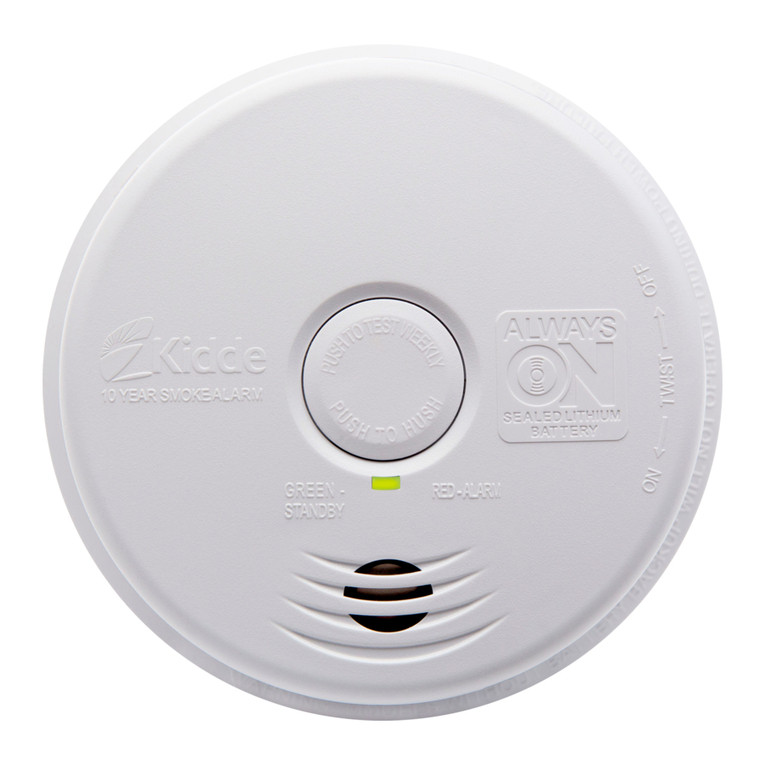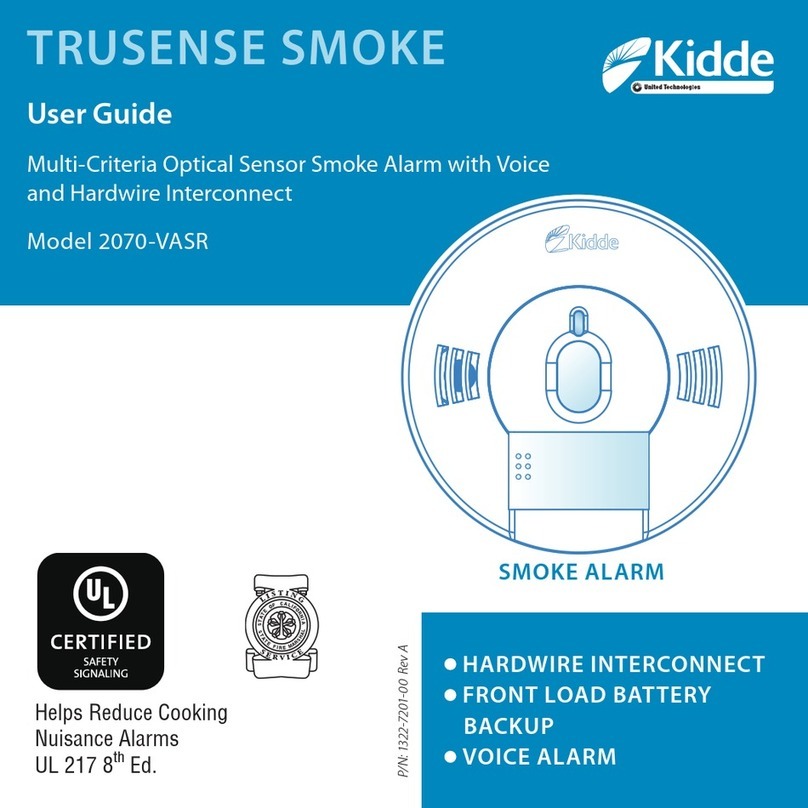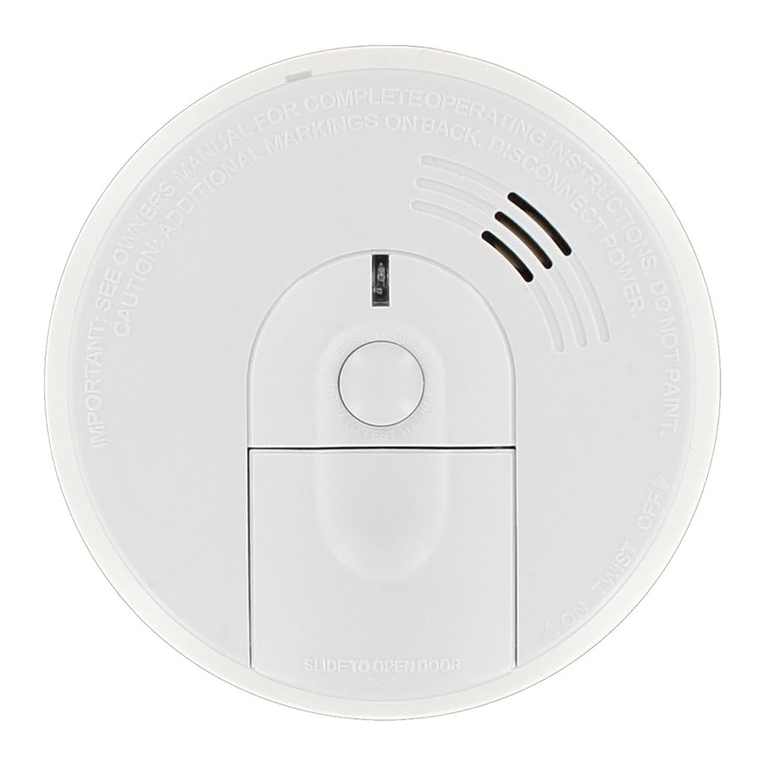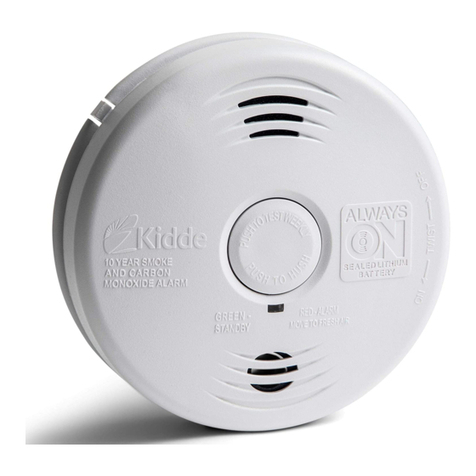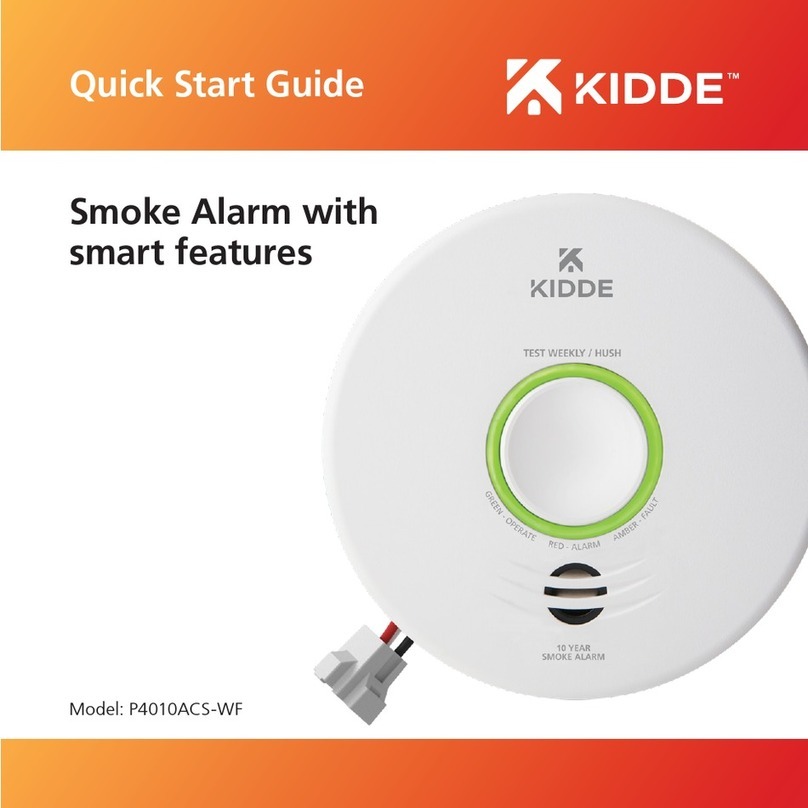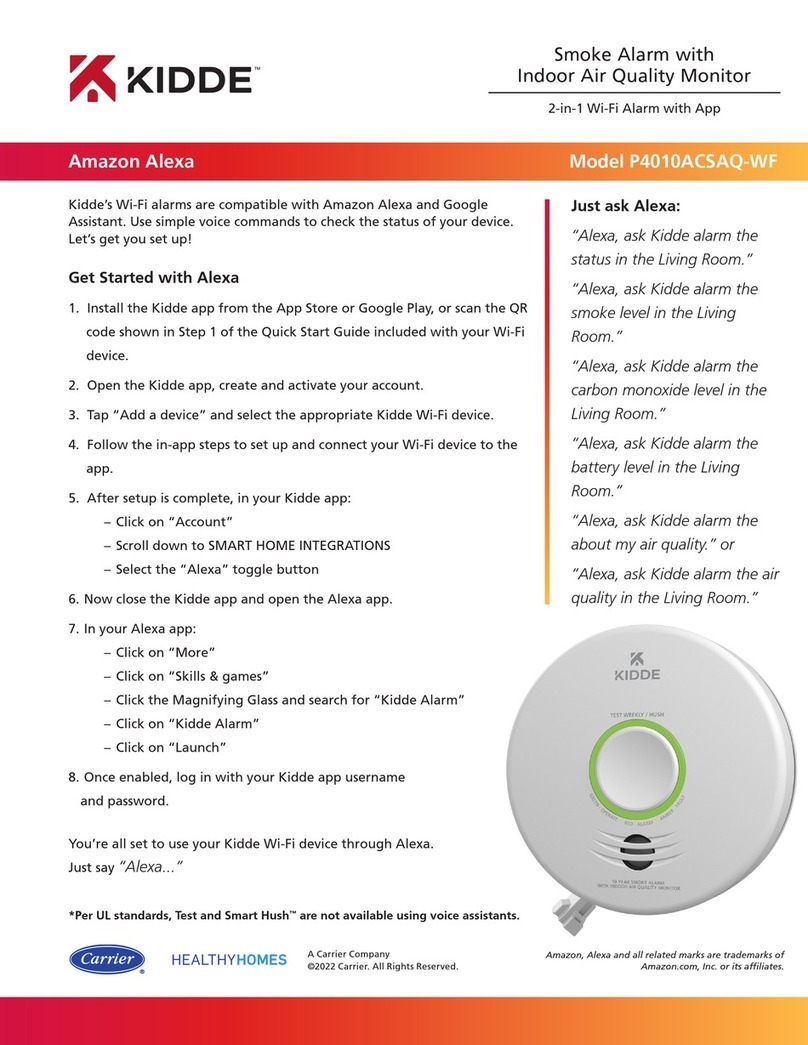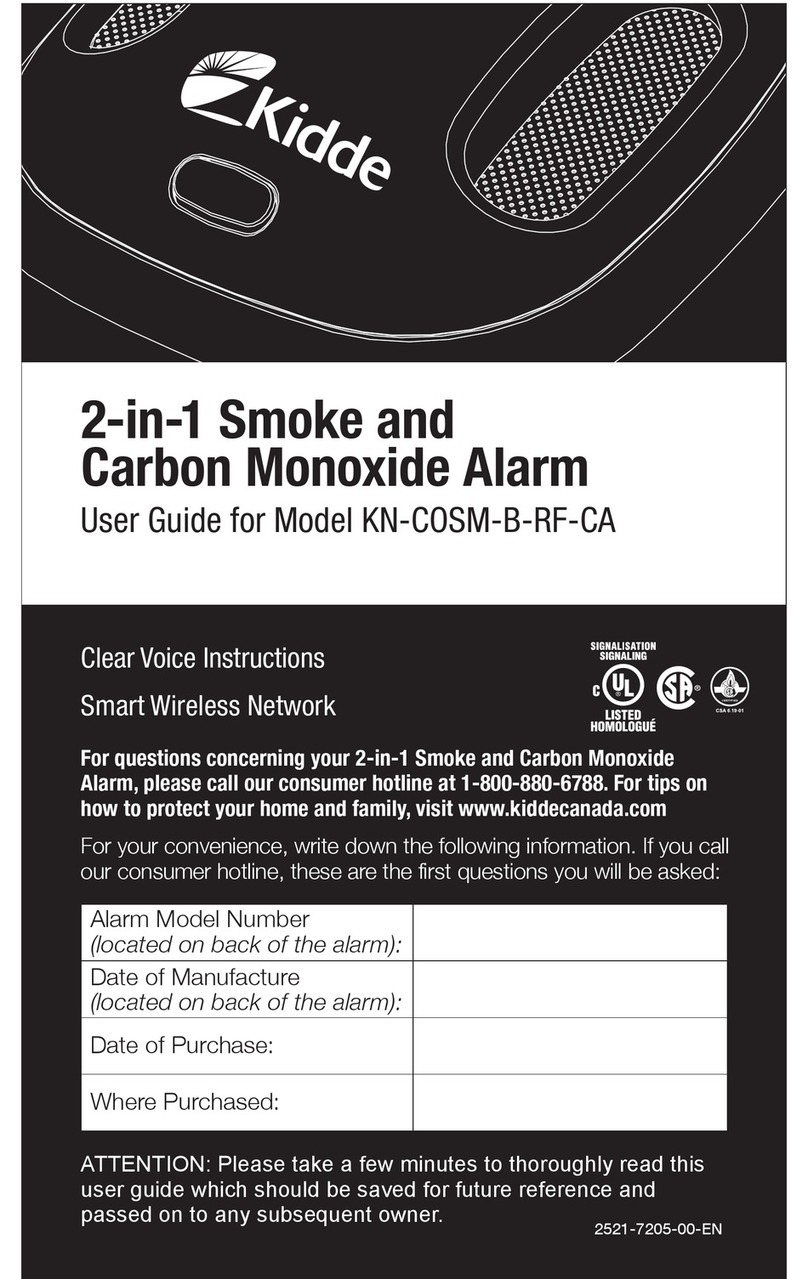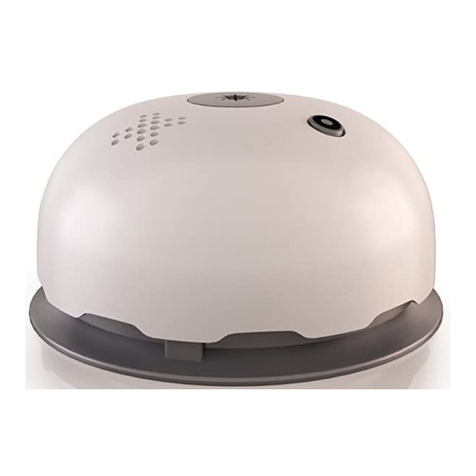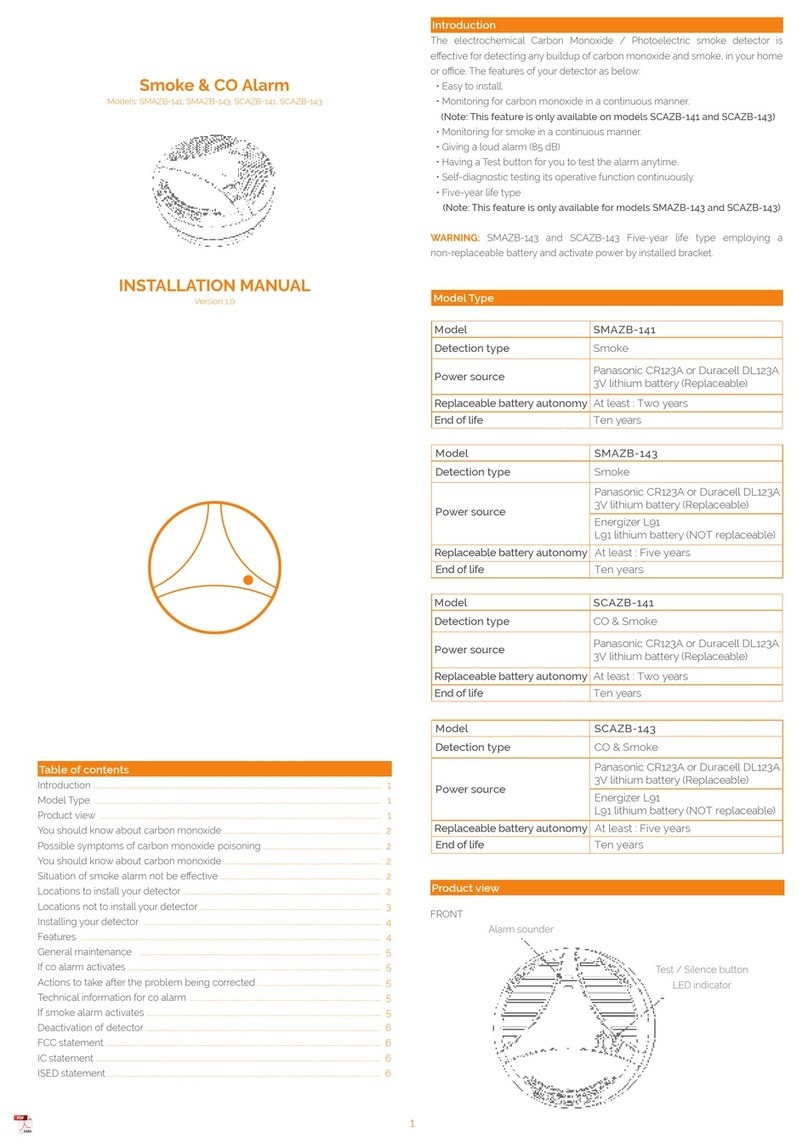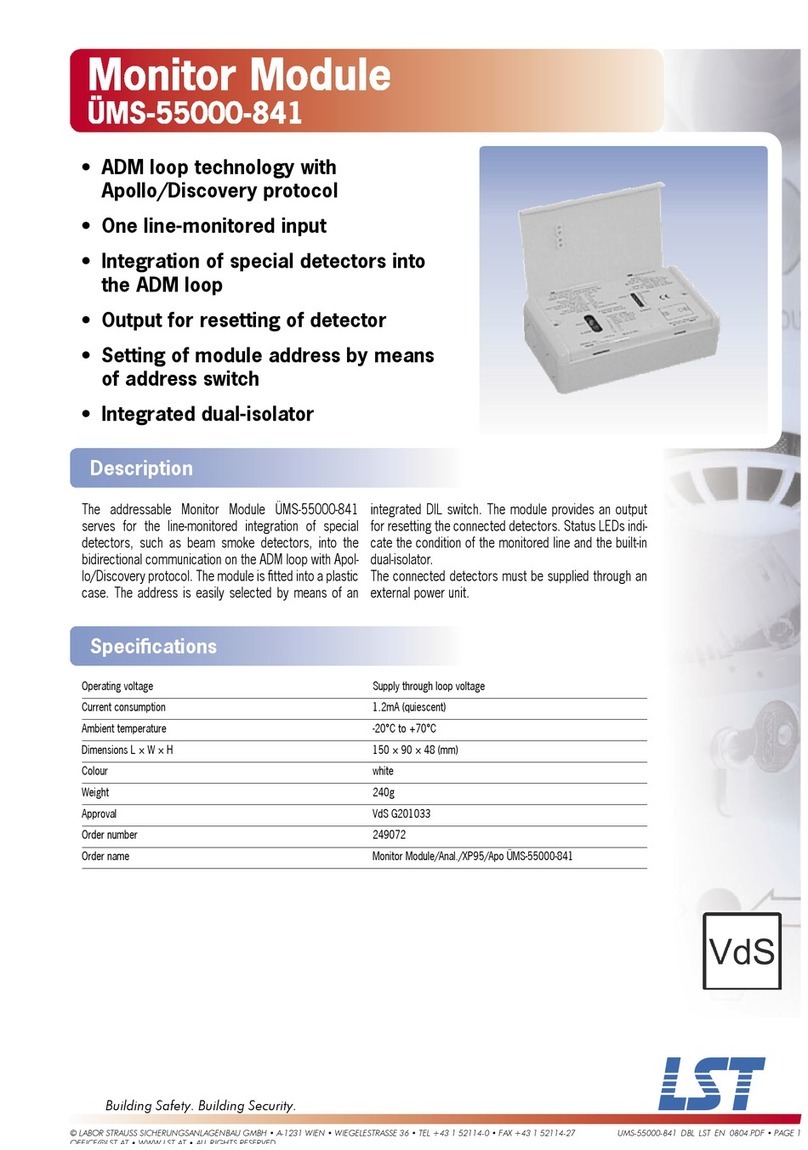SMOKE ALARM DESCRIPTION
Model FADC230 Ionisation 230V AC smoke alarm
with Easy Access Battery Door and
False Alarm Control
SMOKE ALARM FEATURES
•Interconnects with up to 24 alarms . Unique power connector prevents interconnection
with incompatible smoke alarms or security systems.
•Tamper-resist bracket quickly snaps into place and serves as a safeguard against
tampering.
•Multi-purpose green and red LEDs indicate that the smoke alarm is receiving AC
power, working under normal operation, in alarm, or under False Alarm Control.
•Loud alarm horn—85 decibels at 3 metres (10 feet)—sounds to alert you of an
emergency.
• Test button checks smoke alarm operation.
• Feature False Alarm Control, which, when activated, quiets unwanted alarms for up to 15
minutes.
• Features an easy acces front loading battery compartment. Battery door can-
not be closed if battery is not properly installed.
• Model FADC230 features a latching LED which blinks the initiating alarm's red
LED 3 times each minute until manually reset.
• Model FADC230 has a ramp-up test horn feature which emits 2 reduced-vol-
ume beeps before reaching the full 85db level during testing.
IMPORTANT SAFETY INFORMATION
PLEASE READ AND SAVE THESE
INSTRUCTIONS
WARNING
•AC smoke alarms require constant 230V AC, 50Hz power to operate properly.
Mains-powered smoke alarms WILL NOT work if AC power is not connected or has
failed or been interrupted for any reason. This alarm requires a working 9-volt battery
to operate properly in the event of a power failure. DO NOT use any other kind of
battery except as specified in this manual. DO NOT connect this smoke alarm to
any other type of smoke alarm or auxiliary device except those listed in this manual.
•DO NOT remove or disconnect battery or turn off AC power to quiet unwanted
alarms. This will remove your protection. Open windows or fan the air around smoke
alarm to silence it. This alarm features a False Alarm Control button which, when activat-
ed, will quiet unwanted alarms for up to 15 minutes.
•The Push-to-Test button accurately tests all smoke alarm functions. DO
NOT use any other test method. Test smoke alarm weekly to ensure proper
operation.
•This smoke alarm should be installed only by a qualified electrician.
•This smoke alarm is designed to be used inside a single family household
only. In multi-family buildings, each individual living unit should have its own smoke
alarms. Do not install in non-residential buildings or places which house many peo-
ple like hotels, motels, dormitories, hospitals, nursing homes, or group homes of
any kind. This smoke alarm is not a substitute for a complete alarm system.
•Install a smoke alarm in every room and on every level of the home. Smoke
may not reach the smoke alarm for many reasons. For example, if a fire starts in
a remote part of the home, on another level, in a chimney, wall, roof, or on the
other side of a closed door, smoke may not reach the smoke alarm in time to
alert household members. A smoke alarm will not promptly detect a fire EXCEPT
in the area or room in which it is installed.
•Interconnected smoke alarms installed in every room and on every level of
the household offers maximum protection. We recommend interconnecting
smoke alarms so that when one smoke alarm senses smoke and sounds its alarm,
all others will sound as well. Do not interconnect smoke alarms from one individual
family living unit to another. Do not connect this smoke alarm to any other type of
alarm or auxiliary device.
•Smoke alarms may not alert every household member every time. The
alarm horn is loud in order to alert individuals of a potential danger. However,
there may be limiting circumstances where a household member may not hear
the alarm (i.e. outdoor or indoor noise, sound sleepers, drug or alcohol usage,
the hearing impaired, etc.). If you suspect that this smoke alarm may not alert a
household member, install and maintain specialty smoke alarms. Household
members must hear the alarm’s warning sound and quickly respond to it to
reduce the risk of damage, injury, or death that may result from fire. If a house-
hold member is hearing impaired, install special smoke alarms with lights or
vibrating devices to alert occupants.
•Smoke alarms can only sound their alarms when they detect smoke.
Smoke alarms detect combustion particles in the air. They do not sense heat,
flame, or gas. This smoke alarm is designed to give audible warning of a devel-
oping fire. However, many fires are fast-burning, explosive, or intentional.
Others are caused by carelessness or safety hazards. Smoke may not reach
the smoke alarm QUICKLY ENOUGH to ensure safe escape.
•Smoke alarms have limitations. This smoke alarm is not fool-proof and is not
warranted to protect lives or property from fire. Smoke alarms are not a substitute
for insurance. Homeowners and renters should insure their lives and property. In
addition, it is possible for the smoke alarm to fail at any time. For this reason,
you must test the smoke alarm weekly and replace every 10 years.
SMOKE ALARM PLACEMENT
It is recommended to achieve complete coverage protection by installing a
smoke alarm in every room of your home.
At a minimum, smoke alarms shall be installed outside of each separate sleeping
area in the immediate vicinity of the bedrooms and on each additional storey of the
family living unit including basements and excluding crawl spaces and unfinished
attics. Any home requires a minimum of two smoke alarms.
FOR BEST PROTECTION, IT IS RECOMMENDED THAT YOU
INSTALL A SMOKE ALARM IN EVERY ROOM
In addition, it is recommended that all smoke alarms be interconnected.
Typical Efficiency
Home (Apartment)
•Install a smoke alarm on the ceiling or wall
closest to the sleeping area. Install a smoke
alarm with False Alarm Control in the
kitchen/living area.
Typical Single Storey Home
•Install a smoke alarm on the ceiling or wall
inside each bedroom and in the hallway outside
each separate sleeping area. If a bedroom area
hallway is more than 9 m long, install a smoke
alarm at each end.
Typical Two-Storey Home
•Install a smoke alarm on the ceiling or wall
inside each bedroom and in the hallway outside
each separate sleeping area.
If a bedroom area hallway is more than 9 m
long, install a smoke alarm at each end.
•Install a smoke alarm at the top
of a first-to-second floor stairwell.
IMPORTANT SMOKE ALARM PLACEMENT AND
EXCEPTION INFORMATION:
•Install a smoke alarm as close to the centre of the ceiling as possible. If this is not
practical, mount no closer than 10 cm
(4 inches) from a wall or corner. Also, if local codes
allow, install smoke alarms on walls, between 10 and
30 cm (4 and 12 inches) from ceiling/wall intersections.
•Install a minimum of two smoke alarms in every
home, no matter how small the home. Any size
home requires fitting a minimum of two smoke
alarms.
•Install a smoke alarm in each room that is divided by
a partial wall (either coming down from the ceiling at
least 60 cm (24 inches), or coming up from the floor).
•Install smoke alarms on peaked, cathedral, or gabled
ceilings 1 m from the highest point (measured hori-
zontally).
•Install a smoke alarm in lived-in attics or attics which
house electrical equipment like furnaces, air condi-
tioners, or heaters.
DO NOT install smoke alarms:
Near appliances or areas where normal com-
bustion regularly occurs (kitchens, near boil-
ers, hot water heaters). Use specialized
smoke alarms with unwanted alarm control
for these areas.
In areas with high humidity, like bathrooms or areas
near dishwashers or washing machines. Install at least 3 metres
away from these areas.
Near air returns or heating and cooling supply vents. The air could
blow smoke away from the detector, interrupting its alarm.
In rooms where temperatures may fall below 5˚C (41˚F) or rise above
45˚C (113˚F).
In extremely dusty, dirty, or insect-infested areas.
Loose particles interfere with smoke alarm operation.
Do not site this alarm in area where water or other liquids may enter
the alarm.
HOW TO INSTALL THIS SMOKE ALARM
DANGER: ELECTRICAL SHOCK HAZARD. Turn off power at
the main fuse box or circuit breaker by remov-
ing the fuse or switching the circuit breaker to
the OFF position and securing it.
WARNING: Mains operated smoke alarms should be installed
by a qualified electrician in accordance with the
Regulations for Electrical Installations published
by the Institution of Electrical Engineers (BS).
Failure to install this smoke alarm correctly may
expose the user to shock or fire hazards.
WARNING: The smoke alarm, its associated supply, and
interconnect wiring must be installed in accor-
dance with BS 7671 published by the institution
of Electrical Engineers.
•Install smoke alarm on a wall, ceiling, standard electrical box, or surface mount-
ing pattress.
1. Align mounting plate with mounting holes of standard electrical box or surface
mounting pattress. For siting on wall or ceiling, use mounting plate as template to
mark holes. Drill holes (for wall or ceiling only) and insert supplied screw plugs into
holes until flush with wall or ceiling.
2. Secure mounting plate to electrical box, pattress, wall, or ceiling. (Diagram illus-
trates fixing mounting plate to electrical box.)
3. Connect blue wire from connector plug of smoke alarm to neutral (black or
blue) mains power wire.
4. Connect brown wire from connector plug of smoke alarm to live (red or
brown) mains power wire .
5. If interconnection is desired, connect orange wire from connector to intercon-
nect wire between smoke alarms. See section, “Interconnecting Smoke
Alarms.”
NOTE: If this will be a single-station smoke alarm, cover orange wire with electrical
tape and tuck into ceiling, wall, or pattress.
6. Lift open battery pocket door.
7. Connect new 9-volt battery to battery connector inside battery pocket. BE SURE
BATTERY IS SECURELY CONNECTED. Smoke alarm may beep briefly when bat-
tery is installed.
8. Close battery pocket door, snapping it into place.
9. Push button and hold button on front cover of smoke alarm for three (3) sec-
onds. Smoke alarm should sound its alarm horn if battery is fitted correctly.
10. Attach connector plug to pins on back of smoke alarm. Plug will only fit one
way and will snap into place.
11. Gently tug connector to be sure it is attached securely.
12. Position smoke alarm to mounting plate so that keyslot on side of smoke
alarm is to left of tab on mounting plate. Turn clockwise to lock into place.
13. Remove arrow tab and close battery door. Smoke alarm may beep briefly as
door is closed.
14. Test smoke alarm. See “TESTING THE SMOKE ALARM”.
INTERCONNECTING SMOKE ALARMS
•Use 1.5mm2minimum solid or stranded wire with a rating of 230V. When inter-
connecting, maximum wire length between any two is 450 m for 1.5mm2or
1200 m for 2.5mm2(20 OHMS loop resistance).
•This smoke alarm may be interconnected with as many as 24 other Models.
•Connect smoke alarms to a single AC branch circuit. If local codes do not per-
mit, be sure the neutral wire is common to both phases. Wiring must conform
to IEE Regulations for electrical installation.
RED AND GREEN LED INDICATORS
This smoke alarm features red and green LED indicators that can be seen through
the Push-to-Test button or the LED lens above the test button. The LEDs indicate
the following:
GREEN LED
ON — AC power is present.
OFF — AC power is not present.
RED LED
Blinks once a minute — indicating normal operation.
Blinks once a second — smoke alarm senses smoke and simultane-
ously sounds an audible alarm.
Blinks once every 10 seconds — smoke alarm is quieting an unwanted alarm.
(Interconnected system only):
OFF — another smoke alarm in the network has sensed
smoke and is signalling this alarm.
RED blinks 3 times — indicates this unit initiated an
every minute alarm in an inteconnected
system (press the test button
to reset).
RED blinks 4 times every — indicates weak or improperly
minute preceded by an connected battery.
audible chirp
12 3 4
USER’S
MANUAL
PLEASE READ AND SAVE
INSTALLER: Please leave this manual with the product.


